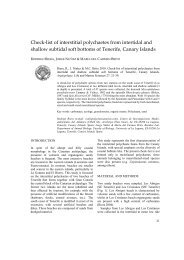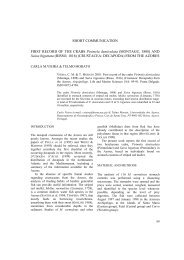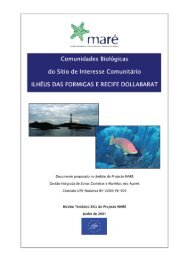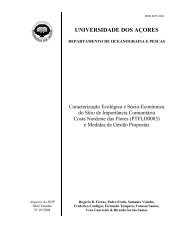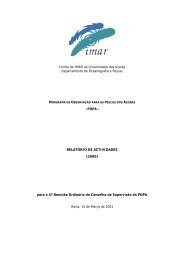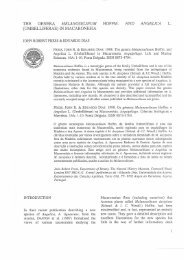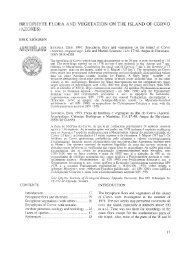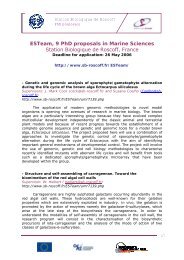relatório actividades de j - DOP/UAç - Universidade dos Açores
relatório actividades de j - DOP/UAç - Universidade dos Açores
relatório actividades de j - DOP/UAç - Universidade dos Açores
Create successful ePaper yourself
Turn your PDF publications into a flip-book with our unique Google optimized e-Paper software.
Jorge Fontes and Miguel Machete. It addresses the study of coastal gill net<br />
fishery and the triggerfish fishery. In the first stage, we interviewed fisherman<br />
from several Islands in or<strong>de</strong>r to un<strong>de</strong>rstand the social, economical and<br />
technological aspects of these fisheries. We also perform experimental gillnet<br />
fishing for estimation of selectivity parameters, collect and analyse historical data<br />
necessary to propose a<strong>de</strong>quate regulation for the Azores archipelago. Triggerfish<br />
life history basic aspects are being studied in or<strong>de</strong>r to analyse the chances for<br />
wi<strong>de</strong>r scale alternative fishery.<br />
NTPA – Study for the implementation of new fisheries techniques in the Azores.<br />
SRAPA / DRP / SRAPA – DRP – 1999 (<strong>DOP</strong> 1)<br />
The aim of this project was testing the implementation of new fisheries<br />
techniques, namely computerised freight "Electric Jigging Machine - Type: 03 -<br />
16" da Oilwind, in Azorean fisheries.<br />
DETRA – Remote sensing techniques implementation in the Azores – Studies of<br />
mesoscale variability and fisheries support.<br />
SRAPA / DRP 2000<br />
Remote sensing techniques are fundamental to oceanographic studies.<br />
Satellite Oceanography is still a recent field, and it is important that Portugal,<br />
namely, the Azores, present themselves as strong candidates to the<br />
implementation of these techniques to ocean studies. Within this framework, a 3year<br />
project called “Implementation of Remote Sensing Techniques in the Azores<br />
– Mesoscale Variability and Fisheries Support (DETRA)” was submitted in 2000<br />
to the Regional Secretary of Fisheries in the Azores, through the Center of IMAR<br />
at the University of the Azores (IMAR-<strong>DOP</strong>/<strong>UAç</strong>). Main objectives of DETRA are<br />
to implement this new scientific area to study marine ecosystem dynamics in the<br />
Azores. To accomplish this, DETRA proposed the installation of a high resolution<br />
satellite station (HRPT) in Faial, Azores (Portugal), to obtain real time AVHRR<br />
(NOAA) and near-real time SeaWiFS (SeaStar) imagery. In April 2001, the HRPT<br />
station of the Azores (named by NASA as “HAZO”) was installed successfully,<br />
becoming the first HRPT station in the Azores to receive SeaWiFS data. HAZO<br />
station receives about 4 to 6 AVHRR and 1 to 2 SeaWiFS images per day. These<br />
images are processed from raw data up to Level-3 data (Sea Surface<br />
Temperature or SST and Ocean Colour) at IMAR-<strong>DOP</strong>/<strong>UAç</strong>. This imagery will be<br />
used in different fields of research within the framework of Ocean Sciences.<br />
NOAA imagery will be also used to support fisheries activities.<br />
GEMAS – Evaluation, management and monitor of un<strong>de</strong>rwater sandbanks<br />
around Faial, Pico and São Miguel<br />
SRAPA / DROTRH - 2001<br />
The aim of this project is the location and volume <strong>de</strong>termination of un<strong>de</strong>rwater<br />
sand banks, around Faial, Pico and São Miguel Islands. The Regional<br />
12



